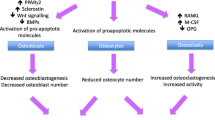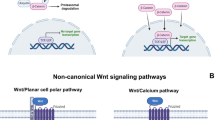Abstract
Purpose
Curcumin is a natural polyphenolic derogate extracted from spice turmeric, exhibiting anti-inflammatory and chemopreventive activities. It was described to interact with the signalosome-associated kinases and the proteasome-ubiquitin system, which both are involved in the osteoclastogenesis. Thus, we hypothesized that curcumin could diminish osteoclast differentiation and function.
Methods
For the experiments considering osteoclast differentiation and resorptional activities, preosteoclasts were cultured for 4 weeks and treated with curcumin at subapoptotic dosages. Derived mature osteoclasts were identified as large, multinucleated cells with expression of tartrate-resistant acid phosphatase activity. Formation of resorption lacunae, a hallmark of osteoclast activity, was quantified using dentine pits and light microscopy. The signaling pathways were examined by ELISA-based methods and by immunoblotting.
Results
Both 1 and 10 μM curcumin abrogated osteoclast differentiation (by 56 and 81%) and function (by 56 and 99%) (P < 0.05) dose-dependently. The effects were accompanied by the inhibition of IκB phosphorylation and NF-κB activation. In contrast, subtoxic doses did not have any significant effects on proteasome inhibition.
Conclusion
This manuscript is the first report that describes the effects of curcumin toward human osteoclastogenesis, and builds the framework for clinical trials of curcumin in the treatment of cancer-induced lytic bone disease.





Similar content being viewed by others
References
Abe M, Hiura K, Wilde J, Moriyama K, Hashimoto T, Ozaki S et al (2002) Role for macrophage inflammatory protein (MIP)-1alpha and MIP-1beta in the development of osteolytic lesions in multiple myeloma. Blood 100:2195–2202
Akatsu T, Takahashi N, Udagawa N, Sato K, Nagata N, Moseley JM et al (1989) Parathyroid hormone (PTH)-related protein is a potent stimulator of osteoclast-like multinucleated cell formation to the same extent as PTH in mouse marrow cultures. Endocrinology 125:20–27
Baeuerle PA, Baltimore D (1988) I kappaB: a specific inhibitor of the NF-kappaB transcription factor. Science 242:540–546. doi:10.1126/science.3140380
Bertolini DR, Nedwin GE, Bringman TS, Smith DD, Mundy GR (1986) Stimulation of bone resorption and inhibition of bone formation in vitro by human tumour necrosis factors. Nature 319:516–518. doi:10.1038/319516a0
Bharti AC, Takada Y, Aggarwal BB (2004) Curcumin (diferuloylmethane) inhibits receptor activator of NF-kappaB ligand-induced NF-kappaB activation in osteoclast precursors and suppresses osteoclastogenesis. J Immunol 172:5940–5947
Bowie A, O’Neill LA (2000) Oxidative stress and nuclear factor-kappaB activation: a reassessment of the evidence in the light of recent discoveries. Biochem Pharmacol 59:13–23. doi:10.1016/S0006-2952(99)00296-8
Boyle WJ, Simonet WS, Lacey DL (2003) Osteoclast differentiation and activation. Nature 423:337–342. doi:10.1038/nature01658
Chuang SE, Yeh PY, Lu YS, Lai GM, Liao CM, Gao M et al (2002) Basal levels and patterns of anticancer drug-induced activation of nuclear factor-kappaB (NF-kappaB), and its attenuation by tamoxifen, dexamethasone, and curcumin in carcinoma cells. Biochem Pharmacol 63:1709–1716. doi:10.1016/S0006-2952(02)00931-0
Collart MA, Baeuerle P, Vassalli P (1990) Regulation of tumor necrosis factor alpha transcription in macrophages: involvement of four kappaB-like motifs and of constitutive and inducible forms of NF-kappaB. Mol Cell Biol 10:1498–1506
Commandeur JN, Vermeulen NP (1996) Cytotoxicity and cytoprotective activities of natural compounds. The case of curcumin. Xenobiotica 26:667–680
Farrugia AN, Atkins GJ, To LB, Pan B, Horvath N, Kostakis P et al (2003) Receptor activator of nuclear factor-kappaB ligand expression by human myeloma cells mediates osteoclast formation in vitro and correlates with bone destruction in vivo. Cancer Res 63:5438–5445
Freeman S (1957) Skeletal disease resulting from disturbed endocrine function or from errors in metabolism. Instr Course Lect 14:286–291
Giuliani N, Bataille R, Mancini C, Lazzaretti M, Barille S (2001) Myeloma cells induce imbalance in the osteoprotegerin/osteoprotegerin ligand system in the human bone marrow environment. Blood 98:3527–3533. doi:10.1182/blood.V98.13.3527
Gori F, Hofbauer LC, Dunstan CR, Spelsberg TC, Khosla S, Riggs BL (2000) The expression of osteoprotegerin and RANK ligand and the support of osteoclast formation by stromal-osteoblast lineage cells is developmentally regulated. Endocrinology 141:4768–4776. doi:10.1210/en.141.12.4768
Hecht M, Heider U, Kaiser M, von Metzler I, Sterz J, Sezer O (2007) Osteoblasts promote migration and invasion of myeloma cells through upregulation of matrix metalloproteinases, urokinase plasminogen activator, hepatocyte growth factor and activation of p38 MAPK. Br J Haematol 138:446–458. doi:10.1111/j.1365-2141.2007.06665.x
Hecht M, von Metzler I, Sack K, Kaiser M, Sezer O (2008) Myeloma cell–osteoclast interaction stimulates expression of cathepsin K, matrix metalloproteinases (MMPs) and urokinase plasminogen activator (uPA) through activation of p38 MAPK and STAT3. Exp Cell Res 314:1082–1093. doi:10.1016/j.yexcr.2007.10.021
Heider U, Langelotz C, Jakob C, Zavrski I, Fleissner C, Eucker J et al (2003) Expression of receptor activator of nuclear factor kappaB ligand on bone marrow plasma cells correlates with osteolytic bone disease in patients with multiple myeloma. Clin Cancer Res 9:1436–1440
Heider U, Fleissner C, Zavrski I, Kaiser M, Hecht M, Jakob C et al (2006) Bone markers in multiple myeloma. Eur J Cancer 42:1544–1553. doi:10.1016/j.ejca.2005.11.034
Henke W, Ferrell K, Bech-Otschir D, Seeger M, Schade R, Jungblut P et al (1999) Comparison of human COP9 signalsome and 26S proteasome lid’. Mol Biol Rep 26:29–34. doi:10.1023/A:1006991419464
Hofbauer LC, Heufelder AE (2001) Role of receptor activator of nuclear factor-kappaB ligand and osteoprotegerin in bone cell biology. J Mol Med 79:243–253. doi:10.1007/s001090100226
Hofbauer LC, Gori F, Riggs BL, Lacey DL, Dunstan CR, Spelsberg TC et al (1999) Stimulation of osteoprotegerin ligand and inhibition of osteoprotegerin production by glucocorticoids in human osteoblastic lineage cells: potential paracrine mechanisms of glucocorticoid-induced osteoporosis. Endocrinology 140:4382–4389. doi:10.1210/en.140.10.4382
Hofbauer LC, Neubauer A, Heufelder AE (2001) Receptor activator of nuclear factor-kappaB ligand and osteoprotegerin: potential implications for the pathogenesis and treatment of malignant bone diseases. Cancer 92:460–470. doi:10.1002/1097-0142(20010801)92:3<460::AID-CNCR1344>3.0.CO;2-D
Jana NR, Dikshit P, Goswami A, Nukina N (2004) Inhibition of proteasomal function by curcumin induces apoptosis through mitochondrial pathway. J Biol Chem 279:11680–11685. doi:10.1074/jbc.M310369200
Jimi E, Aoki K, Saito H, D’Acquisto F, May MJ, Nakamura I et al (2004) Selective inhibition of NF-kappaB blocks osteoclastogenesis and prevents inflammatory bone destruction in vivo. Nat Med 10:617–624. doi:10.1038/nm1054
Kaiser M, Mieth M, Liebisch P, Oberländer R, Jakob C, Rademacher J et al (2008) Serum concentrations of DKK-1 correlate with the extent of bone disease in patients with multiple myeloma. Eur J Haematol 80:490–494. doi:10.1111/j.1600-0609.2008.01065.x
Karin M, Yamamoto Y, Wang QM (2004) The IKK NF-kappaB system: a treasure trove for drug development. Nat Rev Drug Discov 3:17–26. doi:10.1038/nrd1279
Kong YY, Feige U, Sarosi I, Bolon B, Tafuri A, Morony S et al (1999) Activated T cells regulate bone loss and joint destruction in adjuvant arthritis through osteoprotegerin ligand. Nature 402:304–309. doi:10.1038/46303
Mundy GR, Raisz LG, Cooper RA, Schechter GP, Salmon SE (1974) Evidence for the secretion of an osteoclast stimulating factor in myeloma. N Engl J Med 291:1041–1046
Nair SP, Meghji S, Wilson M, Reddi K, White P, Henderson B (1996) Bacterially induced bone destruction: mechanisms and misconceptions. Infect Immun 64:2371–2380
Palombella VJ, Rando OJ, Goldberg AL, Maniatis T (1994) The ubiquitin-proteasome pathway is required for processing the NF-kappaB1 precursor protein and the activation of NF-kappaB. Cell 78:773–785. doi:10.1016/S0092-8674(94)90482-0
Seeger M, Kraft R, Ferrell K, Bech-Otschir D, Dumdey R, Schade R et al (1998) A novel protein complex involved in signal transduction possessing similarities to 26S proteasome subunits. FASEB J 12:469–478
Seyberth HW (1978) Prostaglandin-mediated hypercalcemia: a paraneoplastic syndrome. Klin Wochenschr 56:373–387. doi:10.1007/BF01477292
Sezer O, Heider U, Zavrski I, Kühne CA, Hofbauer LC (2003) RANK ligand and osteoprotegerin in myeloma bone disease. Blood 101:2094–2098. doi:10.1182/blood-2002-09-2684
Suda K, Woo JT, Takami M, Sexton PM, Nagai K (2002) Lipopolysaccharide supports survival and fusion of preosteoclasts independent of TNF-alpha, IL-1, and RANKL. J Cell Physiol 190:101–108. doi:10.1002/jcp.10041
Takahashi N, Udagawa N, Suda T (1999) A new member of tumor necrosis factor ligand family, ODF/OPGL/TRANCE/RANKL, regulates osteoclast differentiation and function. Biochem Biophys Res Commun 256:449–455. doi:10.1006/bbrc.1999.0252
Terpos E, Sezer O, Croucher P, Dimopoulos MA (2007a) Myeloma bone disease and proteasome inhibition therapies. Blood 110:1098–1104. doi:10.1182/blood-2007-03-067710
Terpos E, Dimopoulos MA, Sezer O (2007b) The effect of novel anti-myeloma agents on bone metabolism of patients with multiple myeloma. Leukemia 21:1875–1884. doi:10.1038/sj.leu.2404843
Thompson DD, Seedor JG, Fisher JE, Rosenblatt M, Rodan GA (1988) Direct action of the parathyroid hormone-like human hypercalcemic factor on bone. Proc Natl Acad Sci USA 85:5673–5677. doi:10.1073/pnas.85.15.5673
von Metzler I, Krebbel H, Hecht M, Fleissner C, Mieth M, Kaiser M et al (2007) Bortezomib inhibits human osteoclastogenesis. Leukemia 21:2025–2034. doi:10.1038/sj.leu.2404806
Yaccoby S, Wezeman MJ, Henderson A, Cottler-Fox M, Yi Q, Barlogie B et al (2004) Cancer and the microenvironment: myeloma-osteoclast interactions as a model. Cancer Res 64:2016–2023. doi:10.1158/0008-5472.CAN-03-1131
Zavrski I, Krebbel H, Wildemann B, Heider U, Kaiser M, Possinger K et al (2005a) Proteasome inhibitors abrogate osteoclast differentiation and osteoclast function. Biochem Biophys Res Commun 333:200–205. doi:10.1016/j.bbrc.2005.05.098
Zavrski I, Jakob C, Schmid P, Krebbel H, Kaiser M, Fleissner C et al (2005b) Proteasome: An emerging target for cancer therapy. Anticancer Drugs 16:475–481. doi:10.1097/00001813-200506000-00002
Zavrski I, Kleeberg L, Kaiser M, Fleissner C, Heider U, Sterz J et al (2007) Proteasome as an emerging therapeutic target in cancer. Curr Pharm Des 13:471–485. doi:10.2174/138161207780162908
Acknowledgments
This study was supported by the Deutsche Forschungsgemeinschaft (DFG Klinische Forschergruppe KFO 105).
Author information
Authors and Affiliations
Corresponding author
Rights and permissions
About this article
Cite this article
von Metzler, I., Krebbel, H., Kuckelkorn, U. et al. Curcumin diminishes human osteoclastogenesis by inhibition of the signalosome-associated IκB kinase. J Cancer Res Clin Oncol 135, 173–179 (2009). https://doi.org/10.1007/s00432-008-0461-8
Received:
Accepted:
Published:
Issue Date:
DOI: https://doi.org/10.1007/s00432-008-0461-8




